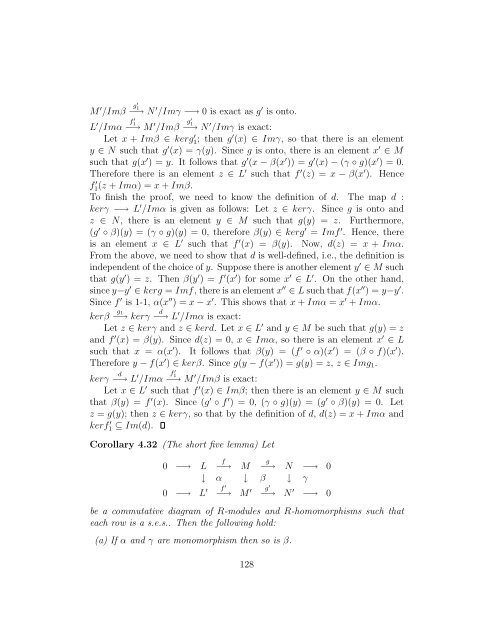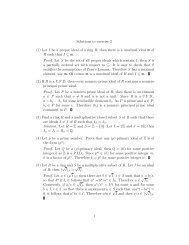Topics in algebra Chapter IV: Commutative rings and modules I - 1
Topics in algebra Chapter IV: Commutative rings and modules I - 1
Topics in algebra Chapter IV: Commutative rings and modules I - 1
Create successful ePaper yourself
Turn your PDF publications into a flip-book with our unique Google optimized e-Paper software.
M ′ /Imβ g′ 1 ′ ′ −→ N /Imγ −→ 0 is exact as g is onto.<br />
L ′ /Imα f ′ 1 ′<br />
g<br />
−→ M /Imβ ′ 1 ′ −→ N /Imγ is exact:<br />
Let x + Imβ ∈ kerg ′ 1; then g ′ (x) ∈ Imγ, so that there is an element<br />
y ∈ N such that g ′ (x) = γ(y). S<strong>in</strong>ce g is onto, there is an element x ′ ∈ M<br />
such that g(x ′ ) = y. It follows that g ′ (x − β(x ′ )) = g ′ (x) − (γ ◦ g)(x ′ ) = 0.<br />
Therefore there is an element z ∈ L ′ such that f ′ (z) = x − β(x ′ ). Hence<br />
f ′ 1(z + Imα) = x + Imβ.<br />
To f<strong>in</strong>ish the proof, we need to know the def<strong>in</strong>ition of d. The map d :<br />
kerγ −→ L ′ /Imα is given as follows: Let z ∈ kerγ. S<strong>in</strong>ce g is onto <strong>and</strong><br />
z ∈ N, there is an element y ∈ M such that g(y) = z. Furthermore,<br />
(g ′ ◦ β)(y) = (γ ◦ g)(y) = 0, therefore β(y) ∈ kerg ′ = Imf ′ . Hence, there<br />
is an element x ∈ L ′ such that f ′ (x) = β(y). Now, d(z) = x + Imα.<br />
From the above, we need to show that d is well-def<strong>in</strong>ed, i.e., the def<strong>in</strong>ition is<br />
<strong>in</strong>dependent of the choice of y. Suppose there is another element y ′ ∈ M such<br />
that g(y ′ ) = z. Then β(y ′ ) = f ′ (x ′ ) for some x ′ ∈ L ′ . On the other h<strong>and</strong>,<br />
s<strong>in</strong>ce y−y ′ ∈ kerg = Imf, there is an element x ′′ ∈ L such that f(x ′′ ) = y−y ′ .<br />
S<strong>in</strong>ce f ′ is 1-1, α(x ′′ ) = x − x ′ . This shows that x + Imα = x ′ + Imα.<br />
kerβ g1<br />
−→ kerγ d<br />
−→ L ′ /Imα is exact:<br />
Let z ∈ kerγ <strong>and</strong> z ∈ kerd. Let x ∈ L ′ <strong>and</strong> y ∈ M be such that g(y) = z<br />
<strong>and</strong> f ′ (x) = β(y). S<strong>in</strong>ce d(z) = 0, x ∈ Imα, so there is an element x ′ ∈ L<br />
such that x = α(x ′ ). It follows that β(y) = (f ′ ◦ α)(x ′ ) = (β ◦ f)(x ′ ).<br />
Therefore y − f(x ′ ) ∈ kerβ. S<strong>in</strong>ce g(y − f(x ′ )) = g(y) = z, z ∈ Img1.<br />
−→ L ′ /Imα f ′ 1<br />
Let x ∈ L ′ such that f ′ (x) ∈ Imβ; then there is an element y ∈ M such<br />
that β(y) = f ′ (x). S<strong>in</strong>ce (g ′ ◦ f ′ ) = 0, (γ ◦ g)(y) = (g ′ ◦ β)(y) = 0. Let<br />
z = g(y); then z ∈ kerγ, so that by the def<strong>in</strong>ition of d, d(z) = x + Imα <strong>and</strong><br />
kerf ′ 1 ⊆ Im(d).<br />
kerγ d<br />
−→ M ′ /Imβ is exact:<br />
Corollary 4.32 (The short five lemma) Let<br />
0 −→ L<br />
f<br />
−→ M g<br />
−→ N −→ 0<br />
↓ α ↓ β ↓ γ<br />
0 −→ L ′ f ′<br />
−→ M ′ g ′<br />
−→ N ′ −→ 0<br />
be a commutative diagram of R-<strong>modules</strong> <strong>and</strong> R-homomorphisms such that<br />
each row is a s.e.s.. Then the follow<strong>in</strong>g hold:<br />
(a) If α <strong>and</strong> γ are monomorphism then so is β.<br />
128



